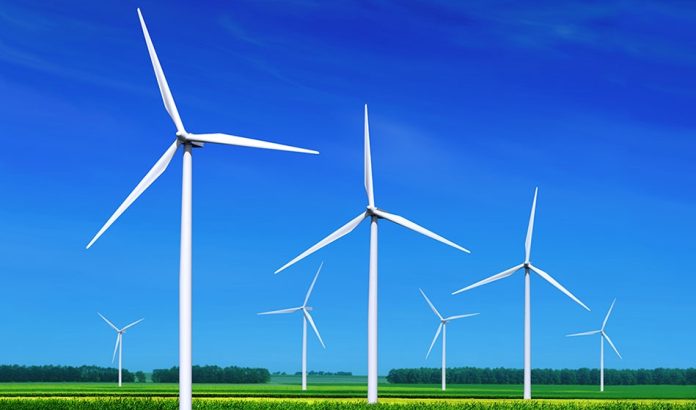
The wind energy industry is growing exponentially. The power generated by the movement of air from an area of high pressure to an area of low pressure is termed wind power or wind energy. It is a clean renewable energy source with the least harmful impact on the global climate as compared to any other energy source. Wind turbines that generate energy do not release emissions that pollute the air or water. Today, due to this growing environmental awareness and the low operational costs after the wind turbine is erected, governments have started to encourage agencies to pursue wind-energy development by offering them incentives. It is estimated by 2050 one third of the world’s electricity needs will be fulfilled by wind power.
Countries Generating Wind Power
Just in this last decade with growing awareness on carbon footprint, corporations and countries have started to increase wind turbine use by more than 25% per year. Further as per the 2019 report by Power-technology.com, the following countries are leading with installed wind capacity: –
1. China
China is a leader in wind energy holding 1/3rd of the world’s total capacity at 221 GW. It even boasts of the world’s largest onshore wind farm ‘Jiuquan Wind Power Base’ also known as’ Gansu Wind Farm’ that features 7,000 wind turbines.
2. United States
The US comes second with 96.4 GW of installed capacity. The country has 6 of the 10 largest onshore wind farms. In 2011, it commissioned the Alta Wind Energy Centre (AWEC) in California, the world’s second-largest onshore wind farm which is jointly operated by Terra-Gen Power, NRG Renew, BHE Renewables, EverPower, and Brookfield Renewable Energy Partners.
3. Germany
With 75.1 GW, Germany has the highest installed wind capacity in Europe. Its largest wind farm is the Gode Windfarms with nearly 1,500 offshore wind turbines which have a combined capacity of 582 MW.
4. India
After China, India ranks second in wind energy in Asia, with a total capacity of 35 GW. The country has two large wind farms — the 1,500-MW Muppandal wind farm in Tamil Nadu and the 1,064-MW Jaisalmer Wind Park in Rajasthan.
The other countries that have started to generate wind power include Spain (23GW), UK (20.7 GW), France (15.3 GW), Brazil (14.5 GW), Canada (12.8 GW), and Italy (10 GW).

Advantages and Disadvantages of Wind Power
Immediate steps are needed to protect the planet from further environmental damage. Sad but true it took the global coronavirus situation to show the world how clean its air can be without carbon emissions. This is a clear message for every country to increase its reliance on a clean energy source like wind energy.
Most wind energy comes from turbines that are around 328 feet (taller than the Statue of Liberty) with 260 feet long blades. As the wind blows the blades spin around turning a shaft connected to a generator that produces electricity.
Wind energy comes in two different types,
i. Onshore Wind energy that is generated by wind farms that have large installations of wind turbines on land.
ii. Offshore Wind energy is when wind over open water is used to generate electricity. In this case, the installations are located in bodies of water mainly in the ocean.
Advantages
- Eco-friendly clean fuel source.
- It is sustainable.
- It is cost-effective, reliable and competitive.
- Uses wind that is an unlimited, free renewable resource.
- After installation, the maintenance cost is almost negligible.
Disadvantages
- Wind turbines are costly to install.
- Communities living close by complain wind turbines are noisy.
- The slow rotating blades pose a threat to birds.
- If there is not enough wind, there’s no electricity generated.
- Since it depends on weather conditions it is not a constant reliable source.
Did you know?
- Wind energy was first developed in 2000 B.C. by ancient Persia and China to pump water for irrigation.
- Albert Betz (1885-1968) a German physicist pioneered wind turbine technology. His wind energy theory was published in 1919 in his book ‘Wind-Energie’.
- The first modern turbine Smith-Putnam was built in Vermont in 1941 and remained the largest wind turbine ever built until 1979.
- The largest turbine in the world is located in Hawaii. It has a height of a twenty storey tall tower and each blade is the length of a football field.
- Wind energy is the only form of alternative energy that doesn’t require water. In 2030, America is planning to save around 30 trillion bottles of water with wind energy.
- A single commercial turbine can power 600 homes.
Conclusion
According to its 2020 report ‘Future of the Wind’ by the International Renewable Energy Agency (IRENA), “wind power can achieve more?than?a quarter?of?total?emissions cuts by 2050, or nearly?6.3?gigatonnes?of?carbon?dioxide. But this entails?increasing the global cumulative installed capacity of?onshore?wind?power?to more?than?threefold? by? 2030? (to 1,787?gigawatts?)?and by? nine-fold? by? 2050?(to 5,044?GW) compared? to?the installed? capacity? in? 2018? (542?GW). For? offshore? wind? power,? the? global? cumulative? installed? capacity? would? increase? almost? tenfold by 2030 (to?228?GW)?and?substantially?towards?2050,?with?total?offshore?installation?nearing?1,000?GW?by?2050”
The time is NOW to start using wind power together with other energy sources for a cleaner TOMORROW!
